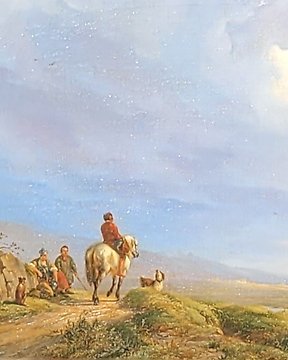
Wouterus Verschuur sr. (1812-1874) - Reizigers in gesprek
No. 84207725

No. 84207725

This romantical painting with famous Aqueduct in the Roman Campagna was executed in 1846 by Niels Frederik Martin Rohde (1816 in Copenhagen - 1886 in Frederiksberg). He was a Danish landscape painter, the son of the accountant at the bankruptcy court Peder Rohde and his wife Johanne, née Holm, attended the Royal Danish Art Academy after his confirmation, where he was a student of Johann Ludwig Lund. He also took lessons from Heinrich Buntzen (1803–1892) and Christen Købke. After receiving a travel scholarship, he went to Germany in 1842, where he stayed in Munich until 1847. During this time, during which he also traveled to Switzerland, Tyrol and Italy, he was influenced by German landscape painting, especially that of the Munich School. In 1852 he married Emilie Johanne Caroline Brusch (* 1825), the daughter of the restorer C. F. Brusch. In 1863, Ancker's legacy enabled him to undertake another study trip, which took him to Düsseldorf. During this time Georg Anton Rasmussen was his student. Rohde's grave lies in the Assistant Cemetery in Copenhagen.
Literature: Thieme/Becker "Allgemeines Kuenstlerlexikon". Leipzig, 1999; SvKL IV, 1961; Weilbach VII, 1998; Theodor Westrin, Ruben Gustafsson Berg (eds.): Nordisk familjebok konversationslexikon och realencyklopedi. 2nd Edition. Volume 23.
Inscription: signed and dated Roma 1846 lower left.
Technique: oil on canvas, original period frame.
Measurements: unframed w 39 1/3" x h 29 1/8" (100 x 74 cm); framed w 49 5/8" x h 41 3/4" (126 x 96 cm).
Condition: in very good condition.
#Legrandtour
How to buy on Catawiki
1. Discover something special
2. Place the top bid
3. Make a secure payment